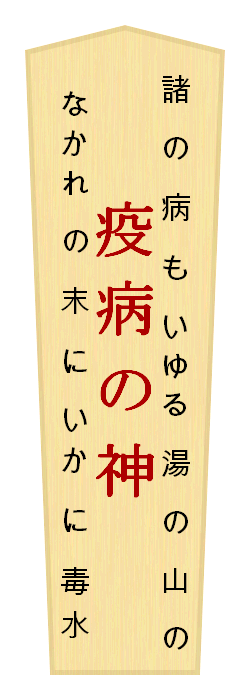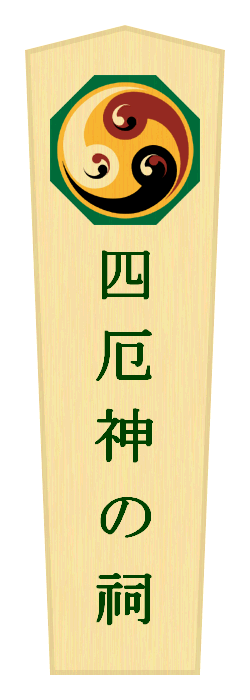疫病の神の御札 「えきびょうのかみのおふだ」
ekibyô no kami no ofuda
 |
 |
 |
| Front side |
 |
Back side |
 |
nakare
no
sue
ni
ika
ni
dokusui |
eki
byô
no
kami |
moro
no
yamai
mo
iyuru
yu
no
yama
no |
 |
shi-yaku-jin no hokora
Shrine of the Four Misfortune kami |
 |
 |
 |
 |
 |
Translation
kanji/kana: 諸 の 病 も いゆる 湯 の 山 の
romaji: moro no yamai mo iyuru yu no yama no
Literal: all kinds-(possesive particle)-illness-(addition indicating particle)-to flow-hot spring-(possessive particle)-mountain-(possessive particle)
Poetic: Diseases of all sorts flow down this mountain where springs heal,
kanji/kana: なかれ の 末 に いか に 毒水
romaji: nakare no sue ni ika ni dokusui
Literal: must not-(possessive particle)-end-(direction indicating particle)-below-(direction indicating particle)-poison water
Poetic: this poison water in the vale is but nature turned full wheel.
宗之
sono
ekibyô no kami, also called
yakubyôgami or
ekibyôgami, is the
• kami of plague and pestilence . ekibyô no kami came to prominence during the Age of Plagues (700 ad - 1050 ad) when Japan suffered from an almost continuous series plagues introduced from the Asian mainland. The
• kyôto gion matsuri , held to appease the kami of disaster and plague, is one outgrowth of this period.
norito are offered to ekibyô no kami on the ninth day of each month.
© 2010-2019 shi-yaku-jin no hokora & BigTime Interactive
shi-yaku-jin no hokora, shiyakujin no hokora, shi-yaku-jin, shiyakujin, minzoku, minkan, folk shinto, folk shintou, Neo-Shinto, NeoShinto, Neoshintou, Shinto, Shintou, Shintoism, kami-no-michi, online shrine, virtual shrine, cyber shrine, shrine, hokora, kami, ekibyou-no-kami, ekibyo-no-kami, ekibyonokami, kami of plague, kami of pestilence, ekigami, yakubyougami, ekibyougami, gami, illness, epidemic, sickness, disease, misfortune, bad luck, ofuda, o-fuda, fuda



